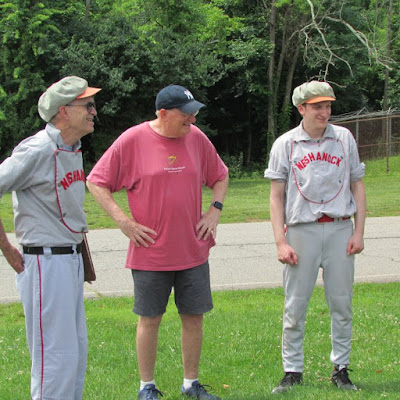After a weekend off, the Flemington Neshanock returned to action on Saturday, traveling to Piscataway, to take on our friends the New Brunswick Liberty. A relatively new vintage club, the Liberty recreate the first base ball club in Middlesex County, founded in 1857. The original Liberty have the distinction of being the first New Jersey team to become members of the National Association of Base Ball Players, a loose confederation of teams that played a major part in establishing the rules of early organized base ball. In addition to playing our friends on the Liberty, the Neshanock were also pleased to welcome back our founder, Brad "Brooklyn" Shaw and his son, Danny "Lunchtime" Shaw. Also playing on Saturday, were three muffins or new members of the Neshanock - Joe Tomlinson, Rick Mosher and Tom Prioli. We were glad to have them with us and hope that they will become regular members of our team.
Playing baseball on Father's Day weekend always reminds me of Billy Crystal's comment in Ken Burn's baseball series that baseball is "the game my father taught me." Many of us can identify with that remark because regardless of our age, we've had a similar experience. Baseball is unique in that respect because fathers teaching the game to their children dates back far beyond any other American sport. It's not unreasonable to believe that by the 1870s, New Jersey's pioneer baseball players were teaching their sons about a game that was simultaneously old, new, and constantly changing - much as it remains today. Depending on when our families came to this country, the experience can date back for generations. The Zinn family, for example, arrived in America on July 3, 1849 when Johannes Zinn landed in New York harbor. While organized baseball was being played then there is no evidence of Zinns playing the game until John G. Zinn (1892-1955) played in the early years of the 20th century. In fact, exactly one hundred years ago, he played first base for the Bordens Milk Company team in the Hackensack industrial league.
There is also no question, he taught the game to his son, Henry G. Zinn (1914-2002) who in turn taught it to me. Almost without thinking about it, I continued the practice with Paul Zinn who is now doing the same with Sophie in softball and Henry in baseball. Hard as it may seem to believe competitive softball wasn't an option for girls when I was growing up so I'm grateful Sophie has the opportunity. There are three things in particular that I remember learning from my father about baseball. The first was how to wear a baseball uniform. In a day when youth players wore wool stirrup stocks without elastic support to hold them up, he figured out a way for me to avoid looking like my peers who constantly had their baseball socks around their ankles. I may not have been a baseball player, but at least I looked like one. That same initial season when I was struggling hitting, he taught me to hold my bat level rather than vertical facilitating a level swing that produced results right away.
Most of all though, the thing that continues to stand out has to do with throwing. Early on he told me that the way to control where your throws go is to focus on where the ball leaves your hand. If your hand is up high, the throw will be high, if it is low, the throw will be low. Not only did I teach that to Paul Zinn, I also stressed it to his teammates when I coached youth baseball almost always with good results. And anyone who has pitched for the Neshanock, especially Bobby "Melky" Ritter, is used to hearing me remind them to "Follow through." This is hardly a groundbreaking new approach to baseball. It's significance lies in how it teaches an important principle in just a few words, an approach to teaching that has a better chance of success because of its simplicity. Now, of course, a new generation of Zinns is learning the game be it softball or baseball. Sophie enjoys pitching and one time I mentioned the release point principle to her. With the withering look, only a nine year old can manage, she said, "I already know that!" Of course, she does, after all, she learned it from her father!






No comments:
Post a Comment